Nanofluid Transport through a Complex Wavy Geometry with Magnetic and Permeability Effects
Abstract
:1. Introduction
2. Materials and Methods
2.1. Numerical Results
2.2. Grid Independence Test
3. Results and Discussion
4. Concluding Remarks
- Near the wavy surface wall, the magnetic field resists the fluid traveling and magnetic strength oppose the flow which results in an enhancement in drag force.
- Silver nanoparticles under the magnetic effects enhance the fluid motion resistance closer to the heated wavy wall and we obtain enhancement in the skin friction coefficient.
- Heat transfer rate in case of silver nanoparticles under the magnetic effects slow down the process of the heat transfer from the heated wavy wall to the ambient fluid temperature.
- Flow rate near the boundary layer portion can be controlled by the nanoparticles’ concentration.
- The process of the heat exchange from the thermal wavy wall can manage by the nanoparticles’ concentration.
- Wavy amplitude increment results in the enhancement of skin friction ( at the crest of the wavy surface but at the trough the skin friction decreases.
- Wavy amplitude increment results in the heat transfer rate (Nu) enhancement at the crest of the wavy surface but at the trough, the heat transfer rate (Nu) decreases.
Author Contributions
Funding
Acknowledgments
Conflicts of Interest
Nomenclature
| Symbols | Names with Units |
| Constant material parameters | |
| Magnetic induction, Tesla NA−1m−2 | |
| Specific Heat, | |
| g | Acceleration of gravity, m2s−1 |
| Da−1 | Inverse of Darcy number |
| k | Thermal Conductivity, Wm−1 K−1 |
| l | Characteristic length of the wavy plate, m |
| M | Magnetic number |
| Dimensionless Pressure, Nm−2 | |
| p | Dimensionless pressure |
| Pr | Prandtl Number |
| Wavy surface | |
| T | Local temperature, K |
| ) | Dimensional Velocity component in (x, y) direction |
| (u,v) | Dimensionless velocity component in the X direction |
| (, ) | Dimensional coordinates |
| (x,y) | Dimensionless coordinates |
| Thermal diffusivity, m2 s | |
| Amplitude of the wavy surface | |
| Coefficient of thermal expansion, K−1 | |
| Wavy parameter | |
| new computational independent variables | |
| Kinematic viscosity, m2 s−1 | |
| Electrical conductivity, | |
| Dimensionless Stream function Subscript | |
| Local density, kgm−3 | |
| Dimensionless temperature | |
| Solid Volume Friction | |
| Dynamic viscosity, kgm−1 s−1 | |
| subscripts | |
| f | Base fluid |
| nf | Nanofluid |
| p | Nanoparticle |
| w | Condition at the surface |
| Condition far away from surface |
References
- Choi, S.U.S. Enhancing Conductivity Thermal of Fluids with Nanoparticles; ASME Publications: New York, NY, USA, 1995; pp. 99–105. [Google Scholar]
- Hosseini, S.M.; Safaei, M.R.; Estellé, P.; Jafarnia, S.H. Heat transfer of water-based carbon nanotube nanofluids in the shell and tube cooling heat exchangers of the gasoline product of the residue fluid catalytic cracking unit. J. Therm. Anal. Calorim. 2019, 140, 351–362. [Google Scholar] [CrossRef] [Green Version]
- Bhatti, M. Biologically Inspired Intra-Uterine Nanofluid Flow under the Suspension of Magnetized Gold (Au) Nanoparticles: Applications in Nanomedicine. Inventions 2021, 6, 28. [Google Scholar] [CrossRef]
- Nayak, M.; Shaw, S.; Khan, M.I.; Pandey, V.; Nazeer, M. Flow and thermal analysis on Darcy-Forchheimer flow of copper-water nanofluid due to a rotating disk: A static and dynamic approach. J. Mater. Res. Technol. 2020, 9, 7387–7408. [Google Scholar] [CrossRef]
- Ellahi, R.; Hussain, F.; Abbas, S.A.; Sarafraz, M.M.; Goodarzi, M.; Shadloo, M.S. Study of Two-Phase Newtonian Nanofluid Flow Hybrid with Hafnium Particles under the Effects of Slip. Inventions 2020, 5, 6. [Google Scholar] [CrossRef] [Green Version]
- Nakayama, A.; Hossain, M. An integral treatment for combined heat and mass transfer by natural convection in a porous medium. Int. J. Heat Mass Transf. 1995, 38, 761–765. [Google Scholar] [CrossRef]
- Singh, H.; Ram, P.; Kumar, A. A study of the effect of chemical reaction and radiation absorption on MHD convective heat and mass transfer flow past a semi-infinite vertical moving plate with time dependent suction. Int. J. Appl. Math Mech. 2011, 7, 38–58. [Google Scholar]
- Ram, P.; Kumar, A.; Singh, H. The effect of chemical reaction and heat transfer on MHD flow of viscous fluid past a moving isothermal vertical porous plate with time dependent suction. Int. J. Theor. Appl. Mech. 2011, 6, 241–254. [Google Scholar]
- Cheng, C.Y. Effect of a magnetic field on heat and mass transfer by natural convection from vertical wavy surfaces in porous media-an integral approach. Int. Comm. Heat Mass Transf. 1999, 26, 935–943. [Google Scholar] [CrossRef]
- Yih, K.A. Coupled heat and mass transfer by free convection over a truncated cone in porous media: VWT/VWC or VHF/VMF. Acta Mech. 1999, 137, 83–97. [Google Scholar] [CrossRef]
- Hassan, H.; Rashidi, M.M. An analytic solution of micropolar flow in a porous channel with mass injection using homotopy analysis method. Int. J. Numer. Method Heat Fluid Flow 2014, 24, 419–437. [Google Scholar] [CrossRef]
- Rashidi, M.; Hayat, T.; Keimanesh, T.; Yousefian, H. A study on heat transfer in a second-grade fluid through a porous medium with the modified differential transform method. Heat Transf.-Asian Res. 2012, 42, 31–45. [Google Scholar] [CrossRef]
- Bhatti, M.M.; Abbas, T.; Rashidi, M.M. Numerical study of entropy generation with nonlinear thermal radiation on magnetohydrody-namics non-Newtonian nanofluid through a porous shrinking sheet. J. Magn. 2016, 21, 468–475. [Google Scholar] [CrossRef] [Green Version]
- Freidoonimehr, N.; Rostami, B.; Rashidi, M.M.; Momoniat, E. Analytical Modelling of Three-Dimensional Squeezing Nanofluid Flow in a Rotating Channel on a Lower Stretching Porous Wall. Math. Probl. Eng. 2014, 2014, 692728. [Google Scholar] [CrossRef] [Green Version]
- Cheng, C.-Y. Natural convection heat and mass transfer near a vertical wavy surface with constant wall temperature and concentration in a porous medium. Int. Commun. Heat Mass Transf. 2000, 27, 1143–1154. [Google Scholar] [CrossRef]
- Maleki, H.; Safaei, M.R.; Togun, H.; Dahari, M. Heat transfer and fluid flow of pseudo-plastic nanofluid over a moving permeable plate with viscous dissipation and heat absorption/generation. J. Therm. Anal. Calorim. 2018, 135, 1643–1654. [Google Scholar] [CrossRef]
- Rees, D.A.S.; Pop, I. A Note on Free Convection Along a Vertical Wavy Surface in a Porous Medium. J. Heat Transf. 1994, 116, 505–508. [Google Scholar] [CrossRef]
- Cheng, C.Y. Double diffusion from a vertical wavy surface in a porous medium saturated with a non-Newtonian fluid with constant wall temperature and concentration. Int. Comm. Heat Mass Transf. 2007, 34, 285–294. [Google Scholar] [CrossRef]
- Kumar, B.V.R. Free convection in a non-Darcian wavy porous enclosure. Int. J. Eng. Sci. 2003, 41, 1827–1848. [Google Scholar] [CrossRef]
- Ghaffarpasand, O. Unsteady double-diffusive natural convection with Soret and Dufour effects inside a two-sided lid-driven skewed enclosure in the presence of applied magnetic field. Sci. Iran. Trans. B Mech. Eng. 2017, 25, 3526–3530. [Google Scholar] [CrossRef] [Green Version]
- Ram, P.; Joshi, V.K.; Makinde, O.D.; Kumar, A. Convective boundary layer flow of magnetic nanofluids under the influence of geo-thermal viscosity. Defect Diffus. Forum 2018, 387, 296–307. [Google Scholar] [CrossRef]
- Akram, S. Nanofluid effects on peristaltic transport of a fourth grade fluid in the occurrence of inclined magnetic field. Sci. Iran. Trans. F Nanotechnol. 2016, 23, 1502–1516. [Google Scholar] [CrossRef] [Green Version]
- Golshokooh, S.; Ramazani, S.A.; Hekmatzadeh, M. Investigating the effect of hybrid silica nanoparticles-copolymer on increasing oil recovery in a three dimensional porous media. Sci. Iran. 2017, 24, 3466–3475. [Google Scholar]
- Sheikholeslami, M.; Rokni, H.B. Numerical simulation for impact of Coulomb force on nanofluid heat transfer in a porous enclosure in presence of thermal radiation. Int. J. Heat Mass Transf. 2018, 118, 823–831. [Google Scholar] [CrossRef]
- Zeeshan, A.; Ellahi, R.; Hassan, M. Magneto hydrodynamic flow of water/ethylene glycol based nanofluid with natural con-vection through a porous medium. Eur. Phys. J. Plus 2014, 129, 261. [Google Scholar] [CrossRef]
- Hakeem, A.A.; Ganesh, N.V.; Ganga, B. Heat transfer of non-Darcy MHD flow of nanofluid over a stretching/shrinking surface in a thermally stratified medium with second order slip model. Sci. Iran. Trans. F Nanotechnol. 2015, 22, 2766–2784. [Google Scholar]
- Ganji, D.D.; Sheikholeslami, M.; Li, Z.; Hosseinnejad, R. Numerical simulation of thermal radiative heat transfer effects on Fe3O4-Ethylene glycol nanofluid EHD flow in a porous enclosure. Sci. Iran. Trans. B Mech. Eng. 2019, 26, 2766–2784. [Google Scholar] [CrossRef] [Green Version]
- Ghaffarpasand, O.; Fazeli, D. Numerical analysis of MHD mixed convection flow in a parallelogramic porous enclosure filled with nanofluid and in the presence of magnetic field induction. Sci. Iran. Trans. F Nanotechnol. 2018, 25, 1789–1807. [Google Scholar]
- Rana, S.; Nawaz, M.; Qureshi, I.H. Numerical study of hydrothermal characteristics in nanofluid using KKL model with Brownian motion. Sci. Iran. Trans. F Nanotechnol. 2019, 26, 1931–1943. [Google Scholar]
- Eswaramoorthi, S.; Sivasankaran, S.; Rajan, S.; Alshomrani, A.S.; Bhuvaneswari, M. Effects of viscous dissipation and convective heating on convection flow of a second grade liquid over a stretching surface: Analytical and numerical study. Sci. Iran. Trans. B Mech. Eng. 2019, 26, 1350–1357. [Google Scholar] [CrossRef] [Green Version]
- Alsagri, A.S.; Hassanpour, A.; Alrobaian, A.A. Simulation of MHD nanofluid flow in existence of viscous dissipation by means of ADM. Case Stud. Therm. Eng. 2019, 14, 100494. [Google Scholar] [CrossRef]
- Sheikholeslami, M.; Rokni, H.B. Magnetic nanofluid flow and convective heat transfer in a porous cavity considering Brownian motion effects. Phys. Fluids 2018, 30, 012003. [Google Scholar] [CrossRef]
- Sheikholeslami, M.; Ganji, D.D.; Javed, M.Y.; Ellahi, R. Effect of thermal radiation on magnetohydrodynamics nanofluid flow and heat transfer by means of two phase model. J. Magn. Magn. Mater. 2014, 374, 36–43. [Google Scholar] [CrossRef]
- Zeeshan, A.; Shehzad, N.; Ellahi, R.; Alamri, S.Z. Convective Poiseuille flow of Al2O3-EG nanofluid in a porous wavy channel with thermal radiation. Neural Comput. Appl. 2017, 30, 3371–3382. [Google Scholar] [CrossRef]
- Zeeshan, A.; Majeed, A.; Akram, M.J.; Alzahrani, F. Numerical investigation of MHD radiative heat and mass transfer of nanofluid flow towards a vertical wavy surface with viscous dissipation and Joule heating effects using Keller-box meth-od. Math. Comput. Simul. 2021, 190, 1080–1109. [Google Scholar] [CrossRef]
- Sheremet, M.A.; Pop, I. Natural convection in a wavy porous cavity with sinusoidal temperature distributions on both side walls filled with a nanofluid: Buongiorno’s mathematical model. J. Heat Transf. 2015, 137, 072601. [Google Scholar] [CrossRef]
- Sheremet, M.; Pop, I.; Bachok, N. Effect of thermal dispersion on transient natural convection in a wavy-walled porous cavity filled with a nanofluid: Tiwari and Das’ nanofluid model. Int. J. Heat Mass Transf. 2016, 92, 1053–1060. [Google Scholar] [CrossRef]
- Ahmed, S.E.; Mahdy, A. Laminar MHD natural convection of nanofluid containing gyrotactic microorganisms over vertical wavy surface saturated non-Darcian porous media. Appl. Math. Mech. Engl. Ed. 2016, 37, 471–484. [Google Scholar] [CrossRef]
- Mahdy, A.; Ahmed, S.E. Laminar Free Convection Over a Vertical Wavy Surface Embedded in a Porous Medium Saturated with a Nanofluid. Transp. Porous Media 2011, 91, 423–435. [Google Scholar] [CrossRef]
- Cheng, C.Y. Non similar solutions for double diffusive convection near a frustum of a wavy cone in porous media. App. Math. Comp. 2007, 194, 156–167. [Google Scholar] [CrossRef]
- Cheng, C.-Y. Double-diffusive natural convection along a vertical wavy truncated cone in non-Newtonian fluid saturated porous media with thermal and mass stratification. Int. Commun. Heat Mass Transf. 2008, 35, 985–990. [Google Scholar] [CrossRef]
- Cheng, C.-Y. Combined heat and mass transfer in natural convection flow from a vertical wavy surface in a power-law fluid saturated porous medium with thermal and mass stratification. Int. Commun. Heat Mass Transf. 2009, 36, 351–356. [Google Scholar] [CrossRef]
- Reddy, P.B.A.; Reddy, A.S.; Reddy, N.B. Magnetohydrodynamic boundary layer flow and heat transfer over a continuous moving wavy surface embedded in a porous medium. Int. J. Appl. Math. Mech. 2012, 8, 7–85. [Google Scholar]
- Mehmood, A.; Iqbal, M.S.; Mustafa, I. Cooling of Moving Wavy Surface through MHD Nanofluid. Z. Nat. 2016, 71, 583–593. [Google Scholar] [CrossRef]
- Hossain, M.A.; Pop, I. Magneto-hydrodynamic boundary layer flow and heat transfer on a continuous moving wavy surface. Act. Mech. 1996, 48, 813–823. [Google Scholar]
- Sheikholeslami, M.; Oztop, H.F. MHD free convection of nanofluid in a cavity with sinusoidal walls by using CVFEM. Chin. J. Phys. 2017, 55, 2291–2304. [Google Scholar] [CrossRef]
- Cebeci, T.; Bradshaw, P. Physical and Computational Aspects of Convective Heat Transfer; Springer: New York, NY, USA, 1988. [Google Scholar]
- Na, T.Y. Computational Methods in Engineering Boundary Value Problems; Academic Press: New York, NY, USA, 1979. [Google Scholar]
- Rees, D.A.S.; Pop, I. Boundary layer flow and heat transfer on a continuous moving wavy surface. Acta Mech. 1995, 112, 149–158. [Google Scholar] [CrossRef]
- Chiam, T.C. Magnetohydodynamic heat transfer over a non-isothermal stretching sheet. Acta Mech. 1997, 122, 169–179. [Google Scholar] [CrossRef]
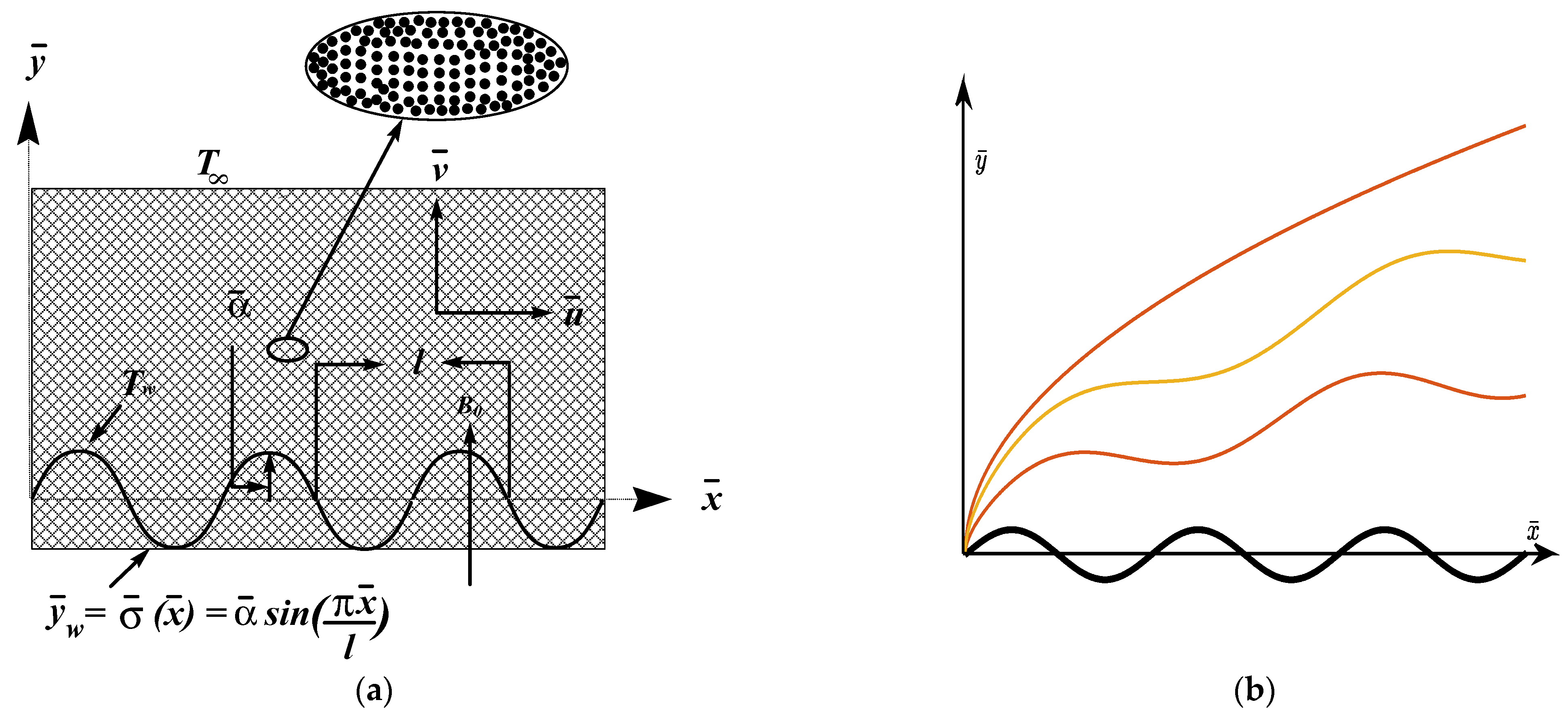
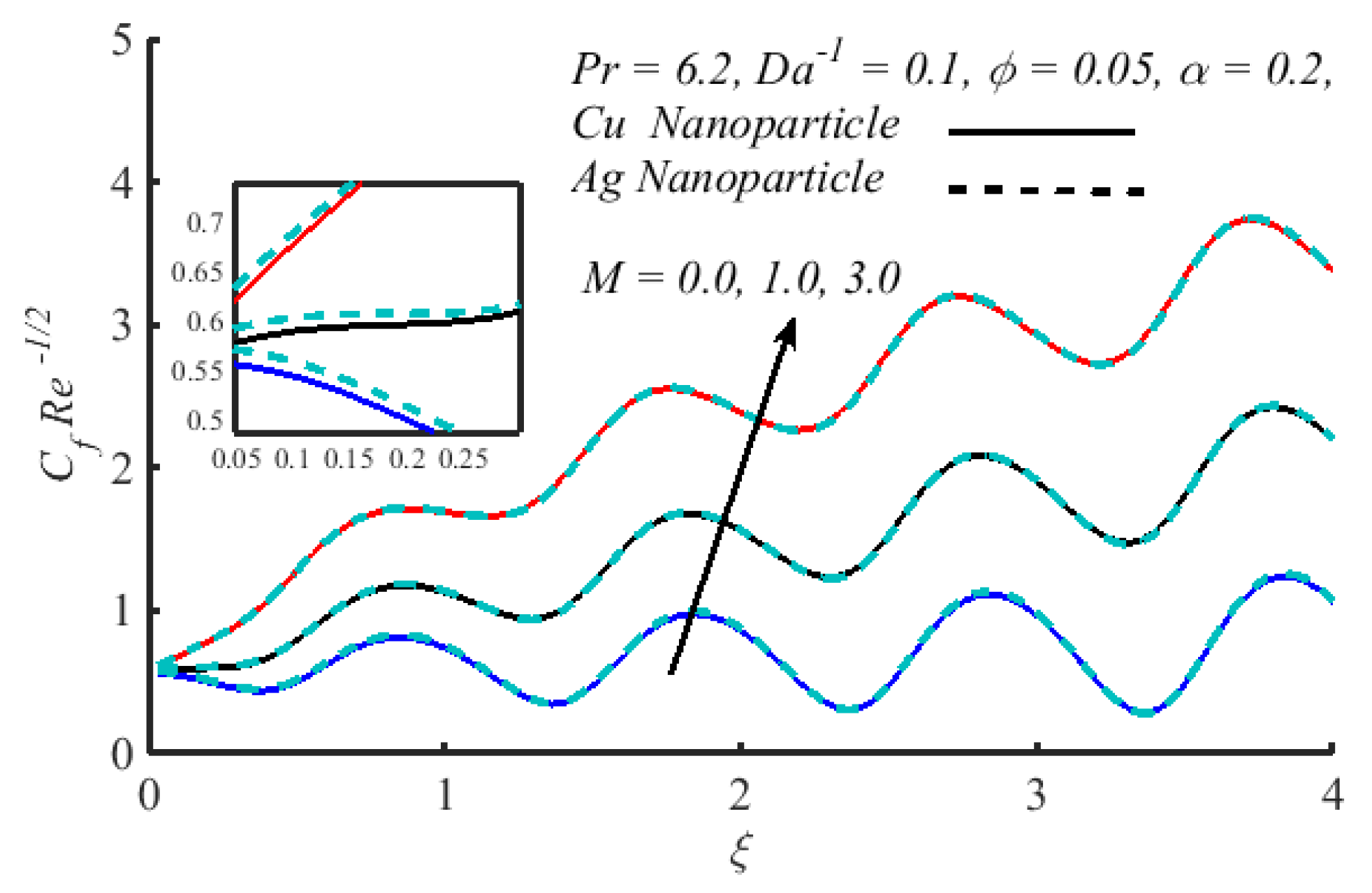
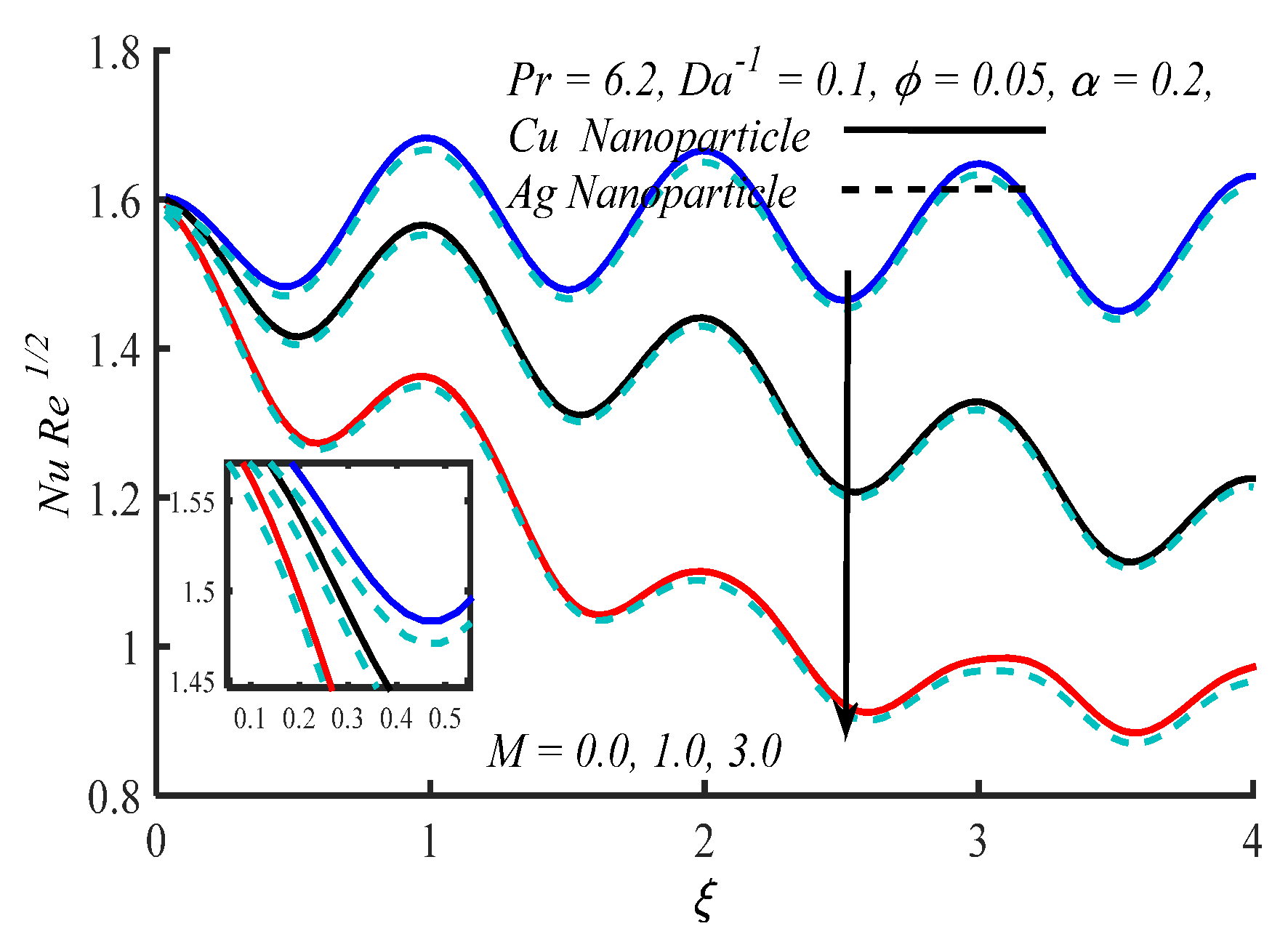
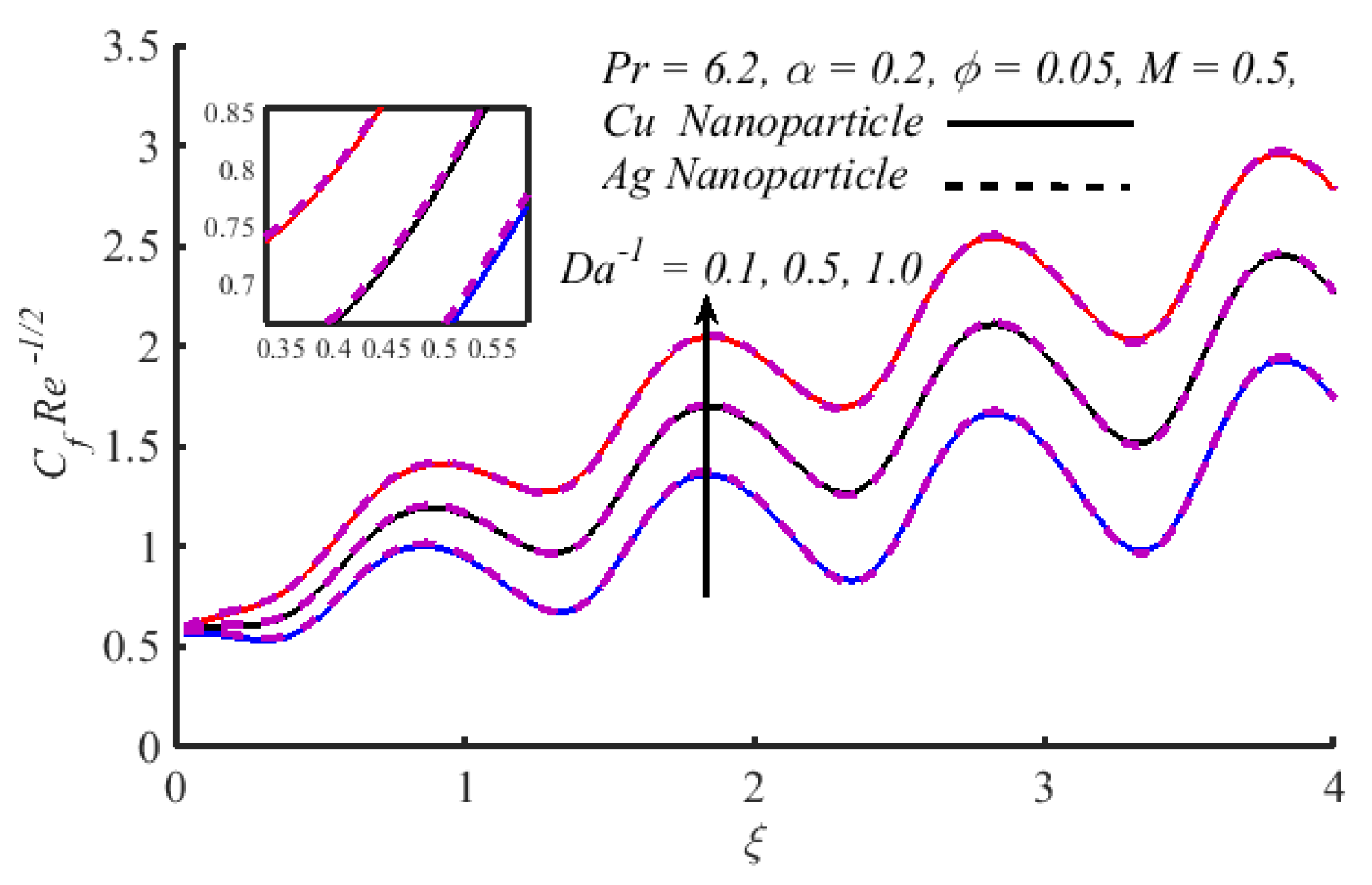
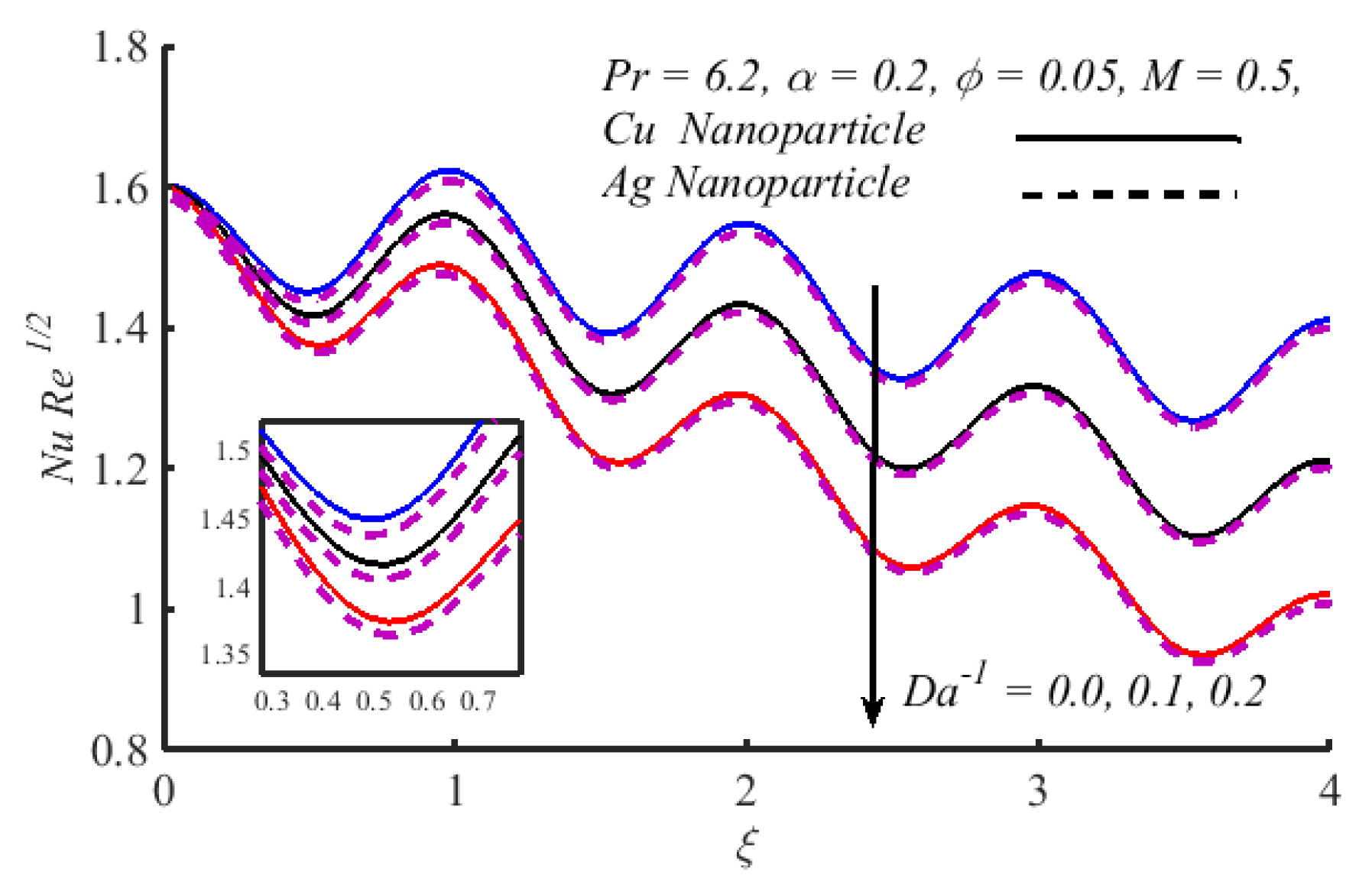

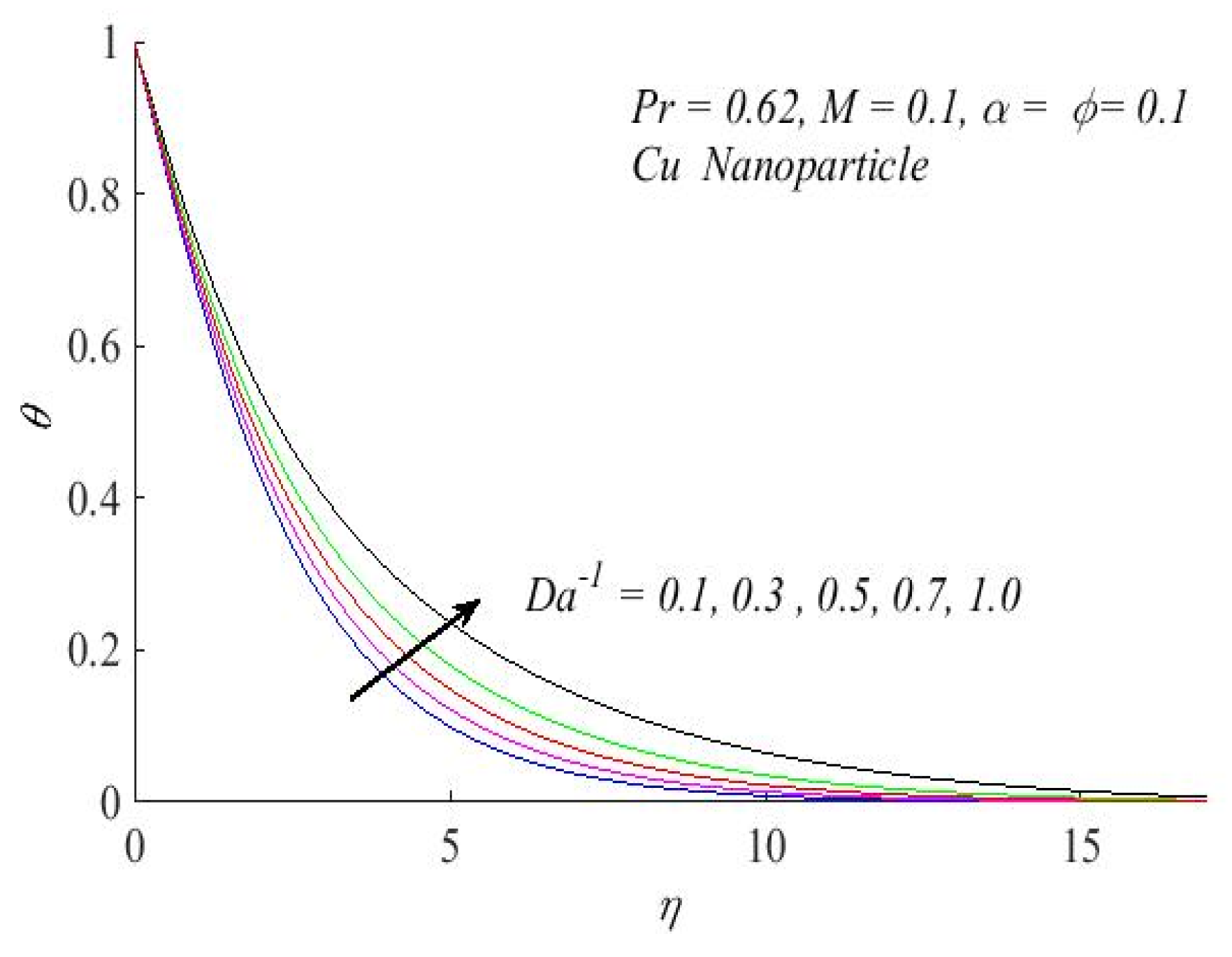
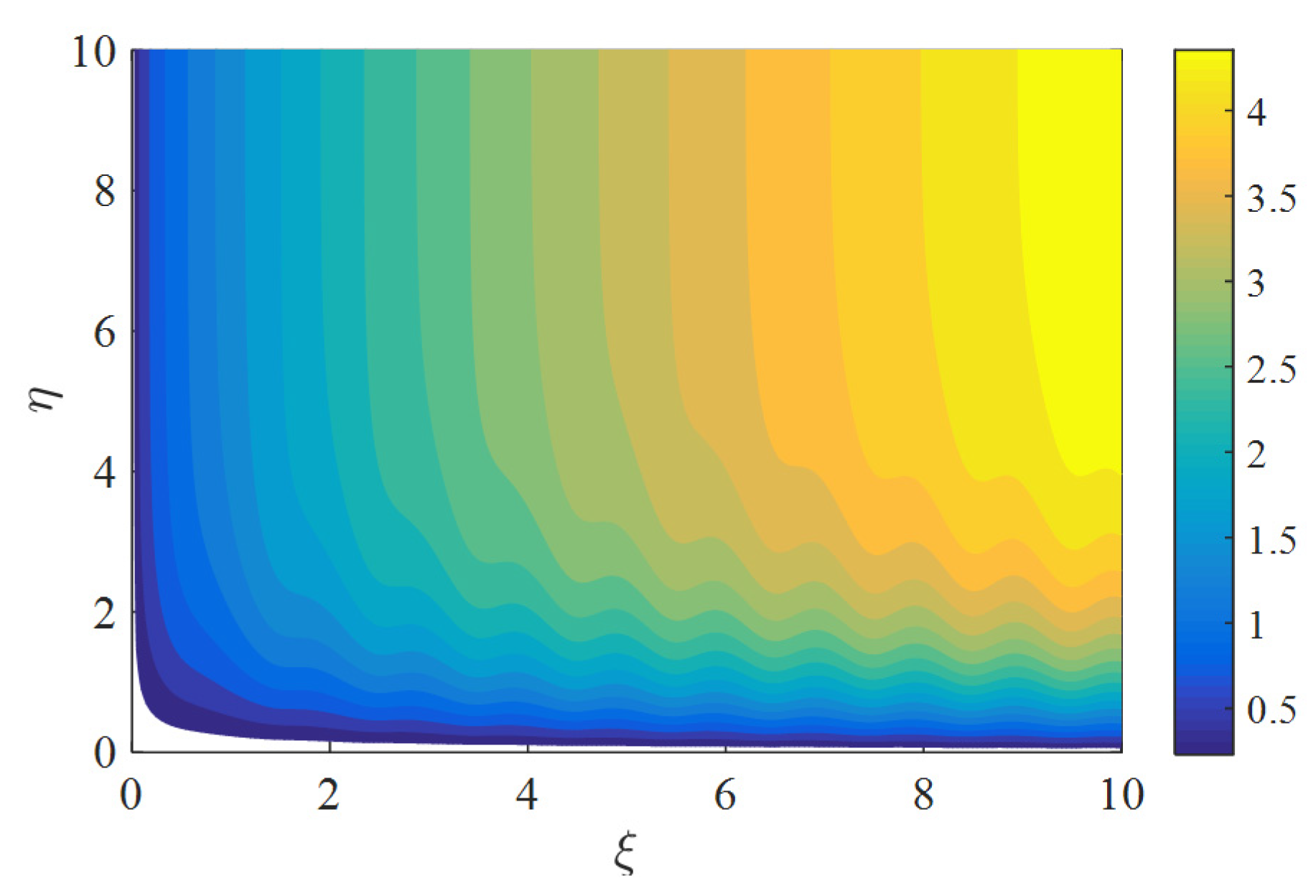

| M = 0.0 | M = 0.01 | M = 0.1 | M = 0.5 | M = 0.5 | M = 0.0 | ||||
|---|---|---|---|---|---|---|---|---|---|
| [44,45,49] | Present | [50] | Present | [50] | Present | [50] | Present | [44,45,49] | |
| 0.0 | (0.44375) (0.4438) (0.4439) | 0.443749 | 0.443751 | 0.443749 | 0.443751 | 0.443749 | 0.443751 | 0.349242 | (0.349242) (0.3492) (0.3509) |
| 0.1 | - | 0.444417 | 0.444421 | 0.450417 | 0.450467 | 0.476872 | 0.476966 | 0.341787 | - |
| 0.2 | - | 0.445084 | 445091 | 0.457057 | 0.457160 | 0.509420 | 0509627 | 0.334250 | - |
| 0.3 | - | 0.445750 | 0.445760 | 0.463676 | 0.463831 | 0.541427 | 0.541753 | 0.326620 | - |
| 0.4 | - | 0.446417 | 0.446429 | 0.470272 | 0.470480 | 0.572896 | 0.573368 | 0.318894 | - |
| 0.5 | - | 0.447083 | 0.447098 | 0.476847 | 0.477107 | 0.603834 | 0.604488 | 0.311072 | - |
| 0.6 | - | 0.447749 | 0.447767 | 0.483400 | 0.483712 | 0.634244 | 0.635127 | 0.303153 | - |
| 0.7 | - | 0.448415 | 0.448435 | 0.489931 | 0.490296 | 0.664133 | 0.665291 | 0.295137 | - |
| 0.8 | - | 0.449081 | 0.449104 | 0.496441 | 0.496858 | 0.693506 | 0.694984 | 0.287028 | - |
| 0.9 | - | 0.449746 | 0.449772 | 0.502928 | 0.503398 | 0.722369 | 0.724201 | 0.278827 | - |
| 1.0 | - | 0.450411 | 0.450440 | 0.509394 | 0.509917 | 0.750730 | 0.752938 | 0.270545 | - |
| 50 | 5 | 3.1871 | 0.5677 |
| 100 | 10 | 3.1802 | 0.5546 |
| 200 | 20 | 3.1777 | 0.5517 |
| 400 | 40 | 3.1766 | 0.5509 |
| 800 | 80 | 3.1761 | 0.5506 |
| 1600 | 160 | 3.1758 | 0.5509 |
| 3200 | 320 | 3.1757 | 0.5505 |
| 4000 | 400 | 3.1757 | 0.5505 |
Publisher’s Note: MDPI stays neutral with regard to jurisdictional claims in published maps and institutional affiliations. |
© 2021 by the authors. Licensee MDPI, Basel, Switzerland. This article is an open access article distributed under the terms and conditions of the Creative Commons Attribution (CC BY) license (https://creativecommons.org/licenses/by/4.0/).
Share and Cite
Iqbal, M.S.; Ghaffari, A.; Riaz, A.; Mustafa, I.; Raza, M. Nanofluid Transport through a Complex Wavy Geometry with Magnetic and Permeability Effects. Inventions 2022, 7, 7. https://doi.org/10.3390/inventions7010007
Iqbal MS, Ghaffari A, Riaz A, Mustafa I, Raza M. Nanofluid Transport through a Complex Wavy Geometry with Magnetic and Permeability Effects. Inventions. 2022; 7(1):7. https://doi.org/10.3390/inventions7010007
Chicago/Turabian StyleIqbal, Muhammad Saleem, Abuzar Ghaffari, Arshad Riaz, Irfan Mustafa, and Muhammad Raza. 2022. "Nanofluid Transport through a Complex Wavy Geometry with Magnetic and Permeability Effects" Inventions 7, no. 1: 7. https://doi.org/10.3390/inventions7010007






